We seem to be in the nerd part of the list, as 6 of the 10 books I’m talking about today are planted firmly within the science fiction genre.
Strike that, I just realized that this entire list is the nerd part of the list. Let’s get back into it, shall we?
50. Finder by Carla McNeil (Dark Horse, 1996)
I could write a hundred pages just about Finder, and it still wouldn’t be enough. One of the most detailed, comprehensively planned comics of all time, Finder isn’t so much a comic book, as it is a world. A worldmight I add, that we’ve only seen a tiny portion of. McNeil’s comics take me forever to read, as they’re not something you can skim through. Ever word has a purpose, and every panel has layers of thematic subtext.
49. Revolver by Matt Kindt (Vertigo, 2010)

Matt Kindt seems to have hit the sweet spot between indie credibility & mainstream success. Super Spy got him mainstream attention, but it’s Revolver that really was his first great work. We’re in pure sci-fi territory here, with our hero jumping between two different realities, with a new jump each time he wakes up. While Kindt has now written dozens of franchise books for Marvel, DC, and Dark Horse, it’s only on books where also does the art, that I feel that his storytelling really opens up.
48. The Incal by Alejandro Jodorowski & Moebius (Humanoids, 1981)
The greatest incomprehensible mess in the history of comics. The Incal by pretty much any definition, is a terrible comic book. The plot makes no sense, the characters are one dimensional, and I couldn’t tell you what it’s about, even though I’ve read it numerous times. So why is The Incal considered such a great book? Because of Moebius, my friend.Because of Moebius. Now, I could have picked literally dozens of other Moebius comics that quite frankly are “better” comics than The Incal. But none of them really showcase his formidable chops as well as Jodorowski’s white whale does. One of the great “art” comics of all time.
47. Scarlet Traces by Ian Edginton & D’Israeli (Dark Horse, 2002)
Do you love War of The Worlds, but thought the wrong team won? Then Scarlet Traces is the comic for you. It’s essentially Edginton & D’Israeli’s sequel to one of the greatest science fiction stories of all time. And it is absolutely fantastic. I’m a huge fan of D’Israeli’s work, but Scarlet Traces might be the very best example of his steampunky brilliance. Check out the the prequel, and sequel, as well.
46. Hark A Vagrant by Kate Beaton (Fantagraphics, 2008)
More of an ongoing anthology of comic strips than an actual comic book, Beaton’s witty & charming approach to history & literary criticism is a perfect pick for that friend of yours that just can’t get into comic books.
45. Shortcomings by Adrian Tomine (Drawn & Quarterly, 2007)
Tomine’s Optic Nerve has produced some great dramatic short stories over the years, but this 3 issue run may be his magnum opus. Tomine’s sharp, tight lines are a perfect complement to this tense exploration on relationships, race, and cultural identity. Although Ben Tanaka is a loathsome protagonist, our desire to see him “learn his lesson” keeps us engaged, and keeps cheering him on. Wonderful example of how comics can be used as effective character studies.
44. Casanova by Matt Fraction, Gabriel Ba, and Fabio Moon (Image, 2006)
Fans of the twists & turns of Sex Criminals might be surprised to find that Matt Fraction has written something even more more complicated and obtuse. So much so, that it makes Sex Criminals feel as accessible as the Smurfs, in comparison. Part science fiction epic, part action thriller, Casanova wears it’s influences on it’s sleeve: Michael Moorcock’s Jerry Cornelius novels, Thomas Pynchon’s work, Alan Moore’s Watchmen, and dozens of others. Ba & Moon’s frenetic density showcase the unlimited storytelling possibilities capable by modern comic creators, like few comics ever have.
43. Pyongyang: A Journey In North Korea by Guy Delisle (Drawn & Quarterly, 2004)
Delisle has done 4 graphic travelogues of variable quality, but it’s his in depth adaptation of his 2 month stay in North Korea that has stuck with me the most over the years. The sheer lunacy of a government that teaches it’s citizens that it’s leaders have superpowers is perfect fodder for a draftsman of Delisle’s talent.
42. King City by Brandon Graham (Tokyopop, 2008)
Even more than Casanova, no other comic on this list defies description quite as much as King City does. Technically it’s sexy, funny science fiction, but that really doesn’t do justice to just how whackadoodle King City really is. There’s a plot, kind of. And there’s characters, some times. But what it’s really about, is simply being a wildly inventive comic. What King City is, who the characters are, are fluid, and simply cogs in the mechanics of Brandon Graham’s brilliance.
41. Berlin by Jason Lutes (Drawn & Quarterly, 1996)
This work of historical fiction is set in pre-WW2 Berlin, during the decline of the Weimar Republic. Although Jason Lutes has been working on this for almost 20 years, Berlin still has 6 issues to go before it wraps up. With Berlin, Lutes sets up a diverse cast of characters and puts them against the backdrop of one of the most important settings of the 20th century. There aren’t nearly enough comics like this on the stands these days, and every issue is a masterclass on how to tell small stories, in a big way.
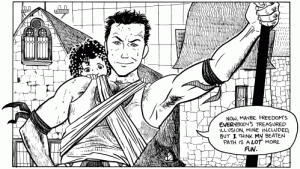
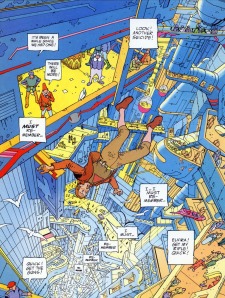

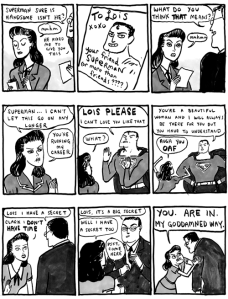
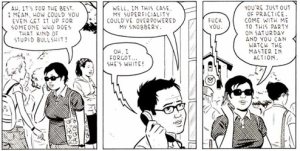



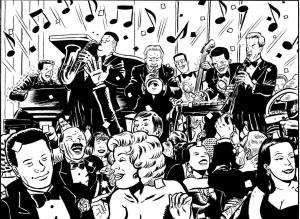
Can’t wait for the rest!